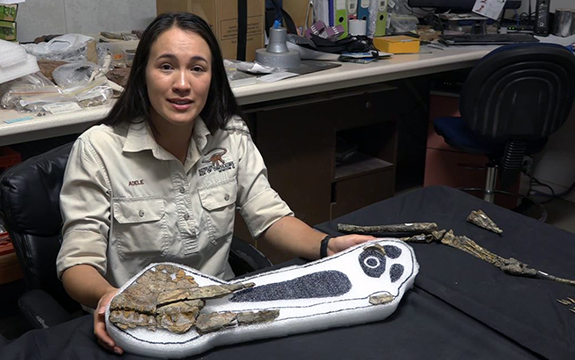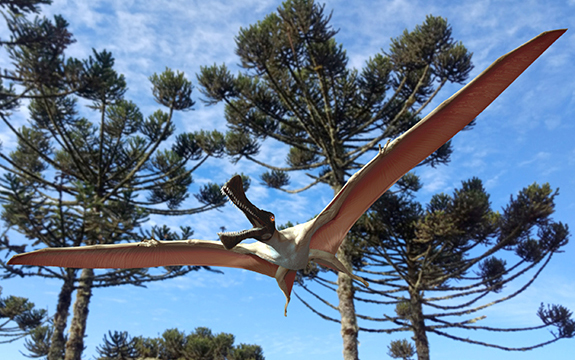Swinburne student examines most complete winged-reptile discovery in Queensland

In Summary
- 96-million-year-old pterosaur found in Queensland
- Swinburne PhD candidate Adele Pentland is leading the research team investigating Ferrodraco lentoni
- Ferrodraco lentoni is the most complete pterosaur that has ever been found in Australia
The discovery of a 96 million year old pterosaur in western Queensland has been hailed as Australia’s most complete winged-reptile discovery.
The fossilised bones of the new genus and species of pterosaur– of an ornithocheirid –were recovered from Belmont sheep station near the northeastern margins of the Winton Formation.
They were discovered in early 2017, by grazier Bob Elliott, who brought the specimens to the Australian Age of Dinosaurs Museum Laboratory in Winton, Queensland.
There they were identified as belonging to an ornithocheirid pterosaur. This group of giant flying reptiles is known to have existed on nearly every continent. They are exceptionally rare in Australia, with their fossil record comprising isolated and fragmentary bones from Queensland, New South Wales, Western Australia and Victoria.
The pterosaur was named Ferrodraco lentoni (Lenton’s iron dragon) and nicknamed Butch after the late Mayor of Winton, Graham ‘Butch’ Lenton.
Swinburne PhD candidate, Adele Pentland is leading the research team for the Australian Age of Dinosaurs Museum, where she is a research associate.
According to Ms Pentland, who has extensively researched Australia’s pterosaurs, the skeleton of Ferrodraco is exceptionally well preserved and comprises five partial vertebrae, eight limb bones, a large portion of the jaw, skull and crest, and 40 isolated and partial teeth.
“This is the most complete pterosaur that has ever been found in Australia and we have somewhere between 10 to 11 percent of the skeleton.
“Based on the wing elements that we managed to recover, we think this pterosaur had a wingspan of about four metres,” Ms Pentland says.
 Paeloartist's impression of pterosaur Ferrodraco lentoni. Credit Travis R Tischler.
Paeloartist's impression of pterosaur Ferrodraco lentoni. Credit Travis R Tischler.
This would have made Ferrodraco lentoni a top aerial predator around 96 million years ago.
“At this time the Winton region was on the southern shores of an inland sea and was globally positioned about where Victoria’s southern coastline is today.”
Ms Pentland says only 15 pterosaur specimens had previously been described from the entire continent. With this discovery the number of pterosaur bones reported from Australia has now tripled.
The fossilised remains of Ferrodraco lentoni are on display at the Australian Age of Dinosaurs Museum in western Queensland.
The paper naming the new pterosaur has been published in Scientific Reports, an open-access online journal published by Nature.

